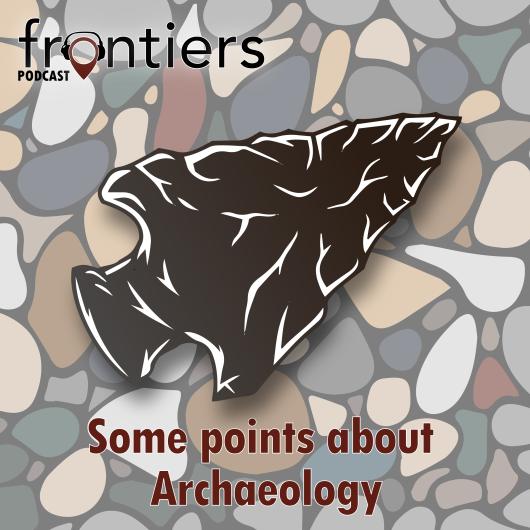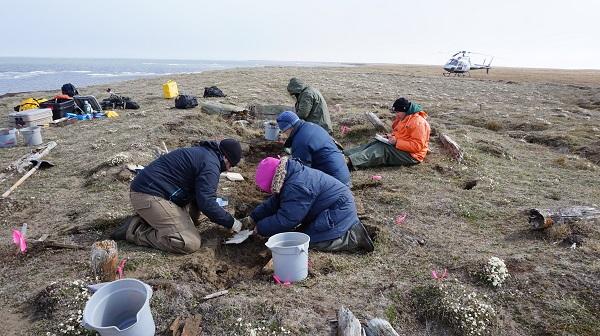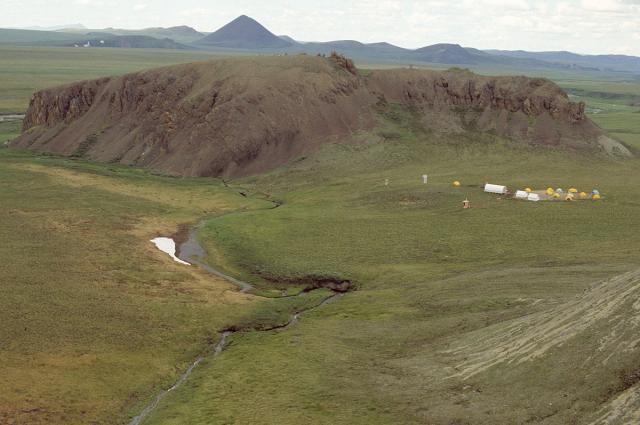You are viewing ARCHIVED content published online before January 20, 2025. Please note that this content is NOT UPDATED, and links may not work. Additionally, any previously issued diversity, equity, inclusion or gender-related guidance on this webpage should be considered rescinded. For current information, visit https://www.blm.gov/blog.
Podcast: Some Points About Archaeology

Transcript
[Jim Hart]: Welcome to the BLM Alaska Frontiers podcast, I'm Jim Hart.
Let's imagine you're on a hike and you come across an old stone arrowhead, an old tin can, or some other type of artifact. What should you do? Just take it?
Or should you leave it undisturbed, realizing it might be something that could be important to Alaska's history and archeologists? In part, the legal answer depends on whose land you're standing, and we'll learn more about that with today's guest, Dr. Robert King, the state archeologist for BLM Alaska.
He holds a doctorate in anthropology with an emphasis in archeology, master's in historical archeology, and undergrad degrees in history and anthropology.
Robert, thanks for coming on.
[Robert King]: Well, thanks, Jim. It's nice to be on.
[Jim Hart]: So what's an archeologist and why are they in the federal government?
[Robert King]: Archeologists, in my view, are historians, they're historians of the past, and they use more than just the written records that are typically used by historians who we think of pondering over books and newspapers and that sort of thing.
Rather, archeologists also supplement their understanding of the past through looking at the things that people have left behind in what we generally term archeological sites.

One of the reasons that archeology is even done in the federal government is that there are federal laws that have been passed since 1906, where the public, the Congress, and the president have collectively agreed, as a culture, that preserving the past and the remnants of the past has importance.
And from those laws, and there's been more than a dozen, and certainly there've been executive orders by the president, and all sorts of actions that have caused the importance of archeology and the remains on public lands to really be considered as very important resources that need to be managed for the benefit of the public today and for the public to come.
[Jim Hart]: Why did you decide to get into archeology with the BLM?
[Robert King]: I've always enjoyed history, and archeology is just an extended add on to history, in my view. I've had that interest since I was very small. Before I was even more than about seven or eight years old. My family traveled a lot.
We visited museums. I was very impressed with the things that I saw. I was intrigued with all things, and from the time I was around six years old, was always interested in archeology and history.
[Jim Hart]: When it comes to archeology, BLM doesn't do it alone. Who is BLM partnered with in this?
[Robert King]: We have a number of different kinds of partners. The public certainly is one [them]. We need people generally to understand the importance of archeology and the perspective it gives to our lives. It tells us about what other people have done on the land at different times, but we also have other kinds of partners as well.

[Jim Hart]: If a person comes across old artifacts, what should they do about it? Some of these artifacts serve as evidence for archeologists to solve a story or an history, don't they?
[Robert King]: They certainly do, and you've made the right statement about how they're evidence that help solve mysteries, and the mysteries are indeed what happened at that site in the past. Who were the people who left that behind? What were their lives like in that?
What a person might inadvertently pick up, not realizing the importance of that artifact for answering those kinds of questions and just removing it. They have taken it out of its context, and they have destroyed, as it were, the chain of information that can be gathered from it or could potentially be gathered from it.
So they should leave it in place. And it's a respectful thing to do. It's not their private property. It's from land that probably is not their own, and they should notify the landowner about that. And if it's a federal landowner, it could be a could end up being a very important discovery.
[Jim Hart]: What's the most interesting work you've taken part in since becoming an archeologist?
[Robert King]: Well, one of the most interesting jobs I've been involved with for many years is education, and that comes in several forms. Some of it has to do with explaining in public meetings about individual archeological sites that are particularly noteworthy for many people.
Other times, it's a more general message of why the past is important and important to save. And then I've also been involved with the development of programs to outreach to students to help instill a better understanding of archeology and a better ethic to protect archeological sites going forward.
[Jim Hart]: What are you looking forward to with your program?
[Robert King]: One of the things that I would like to think is that my program will help more people understand the importance of archeology for their own lives, for helping explain themselves better in the context of how people here in Alaska have lived in the past. And just a deeper and richer understanding of the human condition, I think is a very important thing for all Alaskans to have. If we don't know our past, how can we really understand ourselves today because we're certainly connected to our past, and certainly what we do today affects the future.
So I think the more people that can understand that archeology is relevant to their lives, the better.
[Jim Hart]: Thanks for being here, Robert.
[Robert King]: Well, thank you. Nice to be with you.
[Jim Hart]: That's it for this podcast, be sure to go to the BLM Alaska website and download the Fossils and Artifacts brochure. It'll help you sort out which kinds of fossils and artifacts you can keep and who to contact if you find something.
The link can also be found in the podcast transcript. The BLM Alaska Frontiers podcast is a production of the BLM Alaska Office of Communications.
James Hart, Public Affairs Specialist
Related Stories
- 11-year-old Touren Pope discovers ancient turtle fossil on BLM land in Wyoming
- Popular posts: BLM's most viewed blogs of 2025
- Using science to uncover mysteries of the Mesa archaeological site in Alaska
- Agua Fria National Monument: A desert oasis with a rich history and a vital present
- Virtual adventures await: Discover six BLM public lands you can tour from anywhere
Office
222 W 7th Avenue #13
Anchorage, AK 99513
United States
